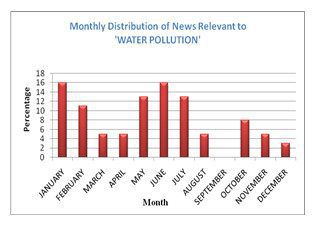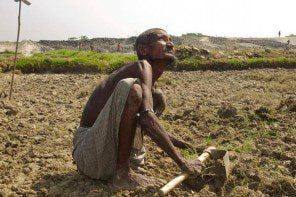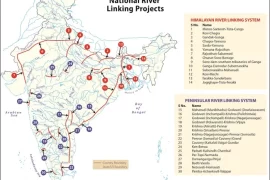Internally Displaced People (IDPs) from riverbank erosion have become one of the most burning issues in the recent discourse on climate change and disaster management worldwide, let alone Bangladesh. As a riverine country, millions of people are vulnerable to being displaced from their origin due to riverbank erosion; Simultaneous destruction to infrastructure, property, roads, railways and flood control embankments often seem inevitable. Academics have expressed concern regarding socio-economic impoverishment and marginalization of the IDPs who have been affected adversely by riverbank erosion (Islam, F. & Rashid, A.N.N.B. (2011) Riverbank Erosion Displacees in Bangladesh: Need for Institutional Response and Policy Intervention.Bangladesh Journal of Bioethics, 2 (2), pp 4-19) . It is therefore evident today that there is no concrete policy or legislative framework from the Bangladesh government’s behalf that would essentially assist affected IDPs, henceforth making it necessary to take crucial steps to develop and employ legitimate policy directives, while also promoting innovative scientific engineering methods to control riverbank erosion.
After the liberation war of 1971, one third of Bangladesh’s population was dislocated. The processes that stimulate internal displacement have become much more diversified ever since. Women and children are considered as being suffering the most, while others are forced to migrate from rural to urban areas due to pressures from environmental, climatic and natural disasters. The displaced eventually becomes landless and unemployed, and their socio—economic inclusion in parallel to acceptance from society only worsens. Furthermore, IDPs are often deprived of basic facilities like healthcare and education, while becoming victims of human rights abuses has been evident in some academic studies (Rahman, M.S. (2012) The Internally Displaced People of Bangladesh: A background paper.). Some studies specified that Bangladesh’s government has in most cases failed to recognize IDPs as ‘especially affected groups’ and are deprived of governmental benefits. Often as it is the case, control measures to combat riverbank erosion is only limited to hard engineering solutions, e.g. construction of embankments, levees, dikes and dams. However, a holistic approach that would also comprehensively take into account the socio-cultural, demographic, economic and ecological criteria would certainly be of benefit for this overlooked community.
The discourse about riverbank erosion induced IDPs agree on a general consensus that adverse effects overpower the minor benefits from riverbank erosion. This section looks at the challenges faced by the IDPs from a potential riverbank erosion scenario.
a) Displacees are not only driven to become homeless, they often lose all their land and assets. Family ties are broken and social bondage is often hampered upon.
b) Any sort of displacement of an individual has a direct impact on generating income, as displacement induces individuals to settle in an alternative area, eventually making it difficult for them to find new sources of income. In some cases, household heads have been observed to have deserted their families under financial duress (Nizamuddin, k., ed.,Disaster in Bangladesh, Dhaka: Disaster Research Training and Management Centre, undated.)
c) People who grow their crops close to riverbanks are always at significant risk because agricultural sources are often their main sources of income. In some recent studies, it was observed that loss of crop due to riverbank erosion has resulted in posing a direct impact on local and national production of crops (Islam, F. & Rashid, A.N.N.B. (2011) Riverbank Erosion Displacees in Bangladesh: Need for Institutional Response and Policy Intervention. Bangladesh Journal of Bioethics, 2 (2), pp 4-19). It was also identified that indigenous crops were often driven towards extinction due to the loss of land and changing occupation of the farmers.
d) The burden of managing households often fell upon the women in the rural areas after an event of riverbank erosion. With the lack of access to safe water and health, women were particularly affected in gender specific ways, in conjunction to social problems as well (dowry, sexual abuse, abandonment).
e) Some academic studies recognized the hazard faced by the IDPs at their new settlement areas from the security perspective. Robbery, harassment and missing infants or children were the principal fears felt by the IDPs.
Riverbank erosion in Bangladesh was only realized as a disaster in 1993, after continuous campaigns from concerned agencies and stockholders. Although the Ministry of Water Resources and the Ministry of Disaster Management collaboratively work as administrative bodies in this regard, riverbank erosion is often considered as a ‘silent catastrophe’, and there is no specific policy or legislative framework for the riverbank erosion displacees either in government or the non-governmental sector (Islam, F. & Rashid, A.N.N.B. (2011) Riverbank Erosion Displacees in Bangladesh: Need for Institutional Response and Policy Intervention. Bangladesh Journal of Bioethics, 2 (2), pp 4-19). The victims of riverbank erosion are not facilitated as appropriately as victims of other environmental disasters, namely floods, tornados, cyclones etc. One key example is that riverbank erosion induced IDPs are deprived of disaster relief assistance, particularly when it comes to providing general cash reliefs and CI sheets (Tin roofing).
Riverbank erosion induced IDPs are also challenged by being provided no temporary shelter and early warning systems. This drives the IDPs to look for alternative destinations to dig mark, which in turn resettles them to inhabit areas with different administration; the officials of the administrations have limited resources and scope for helping the IDPs, which eventually makes these refugees compel to live under the extreme poverty line.
As previously mentioned, to reduce the vulnerabilities of riverbank induced IDPs, the matter must be dealt with the inclusion of socio-economic factors that would eventually make robust the Comprehensive Disaster Management Policy. This role should be undertaken by the National Disaster Management Council (NDMC) and the panel should take into consideration the rights and protection of the displacees in parallel to the creation of a coordination council to coordinate bank-protection works and displacees’ livelihood development programmes. Table 1 and 2 demonstrates how a comprehensive framework can be created to facilitate this scenario.
In contrast to hard engineering used by building levees, dams and dikes in situ Bangladesh’s rivers, this section looks into various methods that essentially address inland riverbank management.
Many researchers have agreed that stabilization of riverbanks can be engineered by employing the usage of synthetic or manufactured materials like walls, mattresses, interlocking blocks and hexagonal structures which can be used to create multiple interventions on the riverbanks (Abbe, T., Bjork, J., Zehni, A. & Park, J.(2011).New innovative, habitat-creating bank protection method. In: Proceedings of the 2011 World Environmental and Water Resources Congress 2011: Bearing Knowledge for Sustainability, pp 2011–2021). However this mentioned process is rather expensive and will not be a suitable option for Bangladeshi riverbanks. On the contrary, Bangladesh could also employ the benefits of bio-engineering, most notably by flattening the slope and planting vegetation. Plants can be attached to the substrate with various devices to resist riverbank erosion. Piling and imbricating large woody debris or logs at the toe of the banks can also be effective (Holanda, F.S.R. &da Rocha, I.P. (2011)Streambanksoil bioengineering approach to erosion control. In: Carpi, A. (Ed.), Progress in Molecular and Environmental Bioengineering—From Analysis and Modeling to Technology Applications. Tech Publisher, pp 553–576),( Lester, R.E. &Boulton, J.B. (2008) Rehabilitating agricultural streams in Australia with wood: a review. Environmental Management, 42, pp310–326) However large scale use can be difficult due to high cost and often reduce plant diversity as compared to natural conditions (Bariteau, L., Bouchard, D., Gagnon, G., Levasseur, M., Lapointe, S. & Berube, M. (2013) A riverbank erosion control method with environmental value.Ecological Engineering, 58, pp 384-392). Although this technique is used across several areas in Bangladesh, riverbank soil in Bangladesh often tend to contain silt and be brittle, essentially making the soil ‘soft’, and making it unsuitable to engineer this method.
A rather traditional, internationally used and cost effective scenario would be laying steeply sloping fill composed of shot rocks and gravel which would effectively artificialize banks, reduce potential for vegetation re-growth and limit access to water for both animals and humans (Federal Emergency Management Agency (FEMA),(2008) Engineering With Nature. Alternative Techniques to Riprap Bank Stabilization. U.S. Department of Homeland Security’s Federal Emergency Management Agency, Washington State, pp34). Although environmental benefits can be argued about in this scenario, this can be a rigid and sustainable platform of defence against riverbank erosion in Bangladesh in many shoreline areas.
The issue of riverbank induced internal displacement is often overlooked at in Bangladesh. Although fatalities associated with this calamity are rare, an estimated 500,000 people are displaced annually due to climate related disasters. Bangladeshi government still has a key role to play in this regard by strengthening the existing policies on the IDPs, whereas not governmental organizations can act as a fuel. The IDPs of Bangladesh need to be viewed as agents rather than simply subjects of rehabilitation programmes. Although it is agreed that all cannot be achieved with one throw of the dice, following a constructive framework that considers innovative solutions to riverbank management, in parallel to acknowledging socio economic parameters, will play a key role to pursue a better situation for IDPs in Bangladesh.





